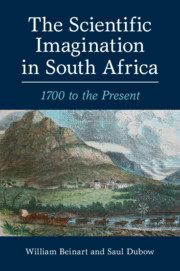Book contents
- The Scientific Imagination in South Africa
- The Scientific Imagination in South Africa
- Copyright page
- Contents
- Map
- Figures
- Acknowledgements
- Introduction: The Scientific Imagination in South Africa
- 1 Scientific Imagination and Local Knowledge at the Cape in the Eighteenth Century
- 2 Scientific Governance and Colonial Institutions, c. 1800–70
- 3 Technological Innovation and the Scientific Imagination in Mining and Agriculture, 1870–1902
- 4 Science, Reconstruction and the Imagining of the First ‘New’ South Africa, 1902–29
- 5 The Commonwealth of Knowledge, 1930–48
- 6 The Republic of Science, 1948–90
- 7 Big Science and Indigenous Knowledge: Post-Apartheid South Africa and the African Renaissance
- Afterword
- Select Bibliography
- Index
6 - The Republic of Science, 1948–90
Published online by Cambridge University Press: 07 May 2021
- The Scientific Imagination in South Africa
- The Scientific Imagination in South Africa
- Copyright page
- Contents
- Map
- Figures
- Acknowledgements
- Introduction: The Scientific Imagination in South Africa
- 1 Scientific Imagination and Local Knowledge at the Cape in the Eighteenth Century
- 2 Scientific Governance and Colonial Institutions, c. 1800–70
- 3 Technological Innovation and the Scientific Imagination in Mining and Agriculture, 1870–1902
- 4 Science, Reconstruction and the Imagining of the First ‘New’ South Africa, 1902–29
- 5 The Commonwealth of Knowledge, 1930–48
- 6 The Republic of Science, 1948–90
- 7 Big Science and Indigenous Knowledge: Post-Apartheid South Africa and the African Renaissance
- Afterword
- Select Bibliography
- Index
Summary
The new apartheid government under D. F. Malan proved adept at using science for its own purposes. The 1949 ‘African Charter’ promoted science and technology as a means to secure regional domination and South Africa’s position as a bulwark of anti-communism. South Africa’s Antarctic research programme regained momentum in the context of the Cold War. The IDC sponsored SASOL, based on an oil-from-coal chemical process, and phosphate-based fertilisers by means of a new parastatal, FOSKOR. Platinum, discovered by Hans Merensky, came of age in the 1970s. Uranium was enriched at a secret plant at Valindaba. The apartheid state also invested heavily in dam construction, hydro-electric power, and irrigation. Agricultural ‘Betterment’ schemes were imposed in the black homelands or Bantustans. From the mid-1970s, state resources were devoted to support weapon production and develop a nuclear capability, and optical astronomy was consolidated under the South African Astronomical Organisation at Sutherland. A major scientific achievement was the world’s first human heart transplant in 1967. Botany, agronomy and biodiversity were major areas of research, as was wildlife conservation. It is therefore possible to distinguish between science under apartheid and apartheid science designed to underpin white supremacy.
Keywords
- Type
- Chapter
- Information
- The Scientific Imagination in South Africa1700 to the Present, pp. 264 - 318Publisher: Cambridge University PressPrint publication year: 2021
- 1
- Cited by



